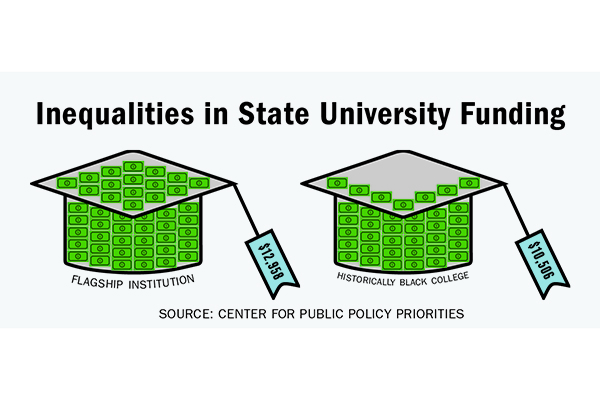Historically Black public colleges and universities are funded $2,500 less per student than the most prominent institutions in Texas, according to a Center for Public Policy Priorities study of the 2019 Texas Public Higher Education Almanac.
In 2018, the average state revenue per student for two Texas flagship universities, Texas A&M University and UT-Austin, was $12,958, according to the report. The report said the average state revenue per student for the two publicly funded HBCUs, Texas Southern University and Prairie View A&M University, was $10,506.
Ashley Williams, the public policy analyst at the center who authored the report, said when the state does not invest in education in HBCUs, the burden falls on students to make up the difference. She said although state investment is not the only factor that contributes to student debt, it does impact it.
“When you are investing less in a group of students, how are they going to afford college?” Williams said. “They are going to borrow, and so they are going to have higher levels of debt. That limits their social mobility.”
The report said the two historically Black universities invest more in students than the flagship universities despite not having the same level of state funding. According to the study, Prairie View spent 21% and Texas Southern University spent 16% of its total funds on student services and scholarships. UT-Austin spent 8% and Texas A&M spent 12% of their total funds on student services and scholarships, according to the study.
Laylan Copelin, communications vice chancellor for the Texas A&M University System, said the report’s comparison between the flagships and the smaller universities is not accurate because it does not include other revenue.
“Bottom line: The study paints an inaccurate, incomplete picture,” Copelin said. “Once you add Permanent University Fund proceeds, the A&M System spends more per student at Prairie View than at the flagship.”
The average student debt at Prairie View A&M is $42,103 and at Texas Southern University is $42,699, as compared to $33,710 at Texas A&M and $38,344 at UT-Austin, according to the almanac. The Student Borrower Protection Center, a research nonprofit focusing on student debt, also released a study two weeks ago that shows Hispanic and Black students are charged more for loans when they come from minority institutions because they often graduate with more debt.
Moira Vahey, director of communication for the Student Borrower Protection Center, said this perpetuates racial inequality in class structure.
“The use of education data in credit (loaning) decisions is particularly concerning given the pattern of disparate access to education in the U.S.,” Vahey said. “Widespread use of this data by lenders could reinforce systemic barriers to financial inclusion for Black and Latinx consumers.”
Williams said there are many factors, including a complicated funding formula that allocates state funds to the universities, that contribute to the disparity. Nevertheless, the historic and systemic inequalities cannot be ignored, she said.
“Systematic, historical inequities certainly contribute to the trends that we see in disparate educational outcomes,” Williams said. “State investments in HBCU institutions matter, and they will have an impact on societal equity going forward.”




















